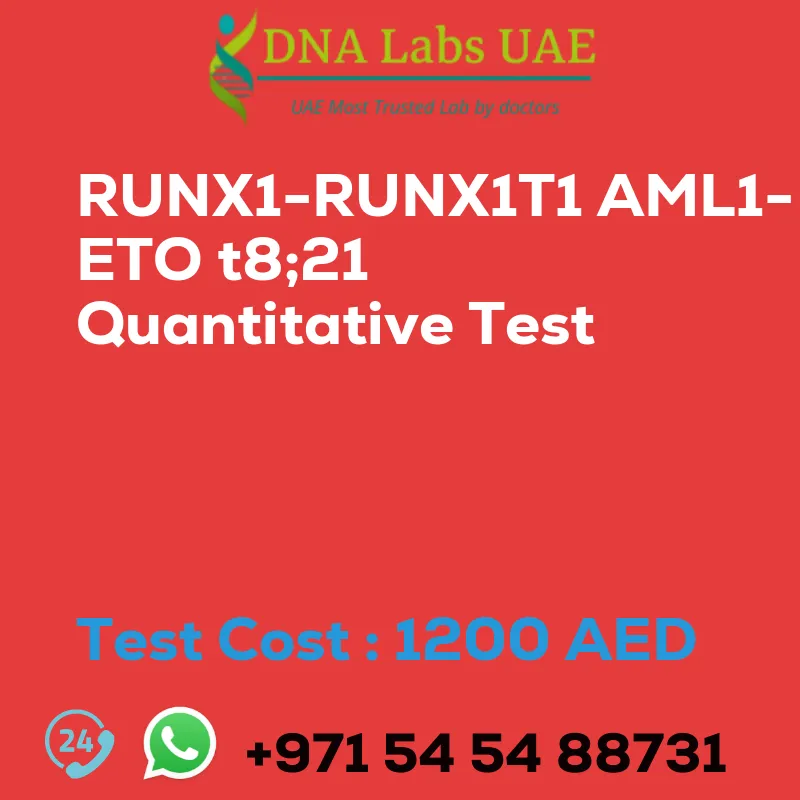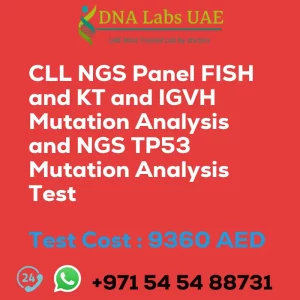RUNX1-RUNX1T1 AML1-ETO t8;21 Quantitative Test
Test Name: RUNX1-RUNX1T1 AML1-ETO t8;21 Quantitative Test
Components: EDTA Vacutainer (2ml)
Price: 1200.0 AED
Sample Condition: Bone marrow / Peripheral blood (Transport immediately)
Report Delivery: 3-4 days
Method: Real Time PCR
Test Type: Genetics
Doctor: General Physician
Test Department: Pre Test Information
RUNX1-RUNX1T1 (AML1-ETO) t(8;21) Quantitative can be done with a Doctor’s prescription. Prescription is not applicable for surgery and pregnancy cases or people planning to travel abroad.
Test Details
The t(8;21) translocation, also known as the RUNX1-RUNX1T1 translocation or AML1-ETO fusion gene, is a chromosomal abnormality commonly found in acute myeloid leukemia (AML). This translocation involves the fusion of two genes, RUNX1 and RUNX1T1, resulting in the production of a chimeric protein called AML1-ETO.
Quantitative analysis of the RUNX1-RUNX1T1 fusion gene is typically performed using molecular techniques such as polymerase chain reaction (PCR) or fluorescence in situ hybridization (FISH). These techniques allow for the detection and quantification of the fusion gene in patient samples.
The quantitative analysis of the RUNX1-RUNX1T1 fusion gene is important for several reasons. Firstly, it can be used for diagnosis and classification of AML, as the presence of this fusion gene is a characteristic feature of t(8;21) AML. Secondly, it can be used for monitoring disease progression and treatment response in patients with t(8;21) AML. Changes in the levels of the fusion gene over time can provide valuable information about the effectiveness of therapy.
Quantitative analysis of the RUNX1-RUNX1T1 fusion gene is typically reported as a ratio of the fusion gene to a reference gene, such as a housekeeping gene. This ratio can be used to determine the level of the fusion gene in the patient sample and compare it to normal levels.
Overall, quantitative analysis of the RUNX1-RUNX1T1 fusion gene is an important tool in the diagnosis, classification, and monitoring of t(8;21) AML.
| Test Name | RUNX1-RUNX1T1 AML1- ETO t8;21 Quantitative Test |
|---|---|
| Components | EDTA Vacutainer (2ml) |
| Price | 1200.0 AED |
| Sample Condition | Bone marrow \/ Peripheral blood (Transport immediately) |
| Report Delivery | 3-4 days |
| Method | Real Time PCR |
| Test type | Genetics |
| Doctor | General Physician |
| Test Department: | |
| Pre Test Information | RUNX1-RUNX1T1 (AML1- ETO) t(8;21) Quantitative can be done with a Doctors prescription. Prescription is not applicable for surgery and pregnancy cases or people planing to travel abroad. |
| Test Details |
The t(8;21) translocation, also known as the RUNX1-RUNX1T1 translocation or AML1-ETO fusion gene, is a chromosomal abnormality commonly found in acute myeloid leukemia (AML). This translocation involves the fusion of two genes, RUNX1 and RUNX1T1, resulting in the production of a chimeric protein called AML1-ETO. Quantitative analysis of the RUNX1-RUNX1T1 fusion gene is typically performed using molecular techniques such as polymerase chain reaction (PCR) or fluorescence in situ hybridization (FISH). These techniques allow for the detection and quantification of the fusion gene in patient samples. The quantitative analysis of the RUNX1-RUNX1T1 fusion gene is important for several reasons. Firstly, it can be used for diagnosis and classification of AML, as the presence of this fusion gene is a characteristic feature of t(8;21) AML. Secondly, it can be used for monitoring disease progression and treatment response in patients with t(8;21) AML. Changes in the levels of the fusion gene over time can provide valuable information about the effectiveness of therapy. Quantitative analysis of the RUNX1-RUNX1T1 fusion gene is typically reported as a ratio of the fusion gene to a reference gene, such as a housekeeping gene. This ratio can be used to determine the level of the fusion gene in the patient sample and compare it to normal levels. Overall, quantitative analysis of the RUNX1-RUNX1T1 fusion gene is an important tool in the diagnosis, classification, and monitoring of t(8;21) AML. |








